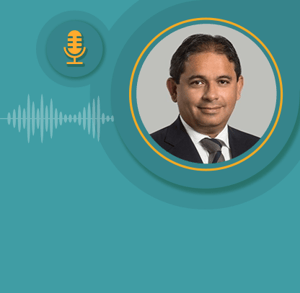In this podcast series, we undertake interviews with global professionals to discuss different aspects of litigation and litigation funding.
Deminor Litigation Funding welcomes you to join this conversation as we summarise the key elements of the conversations between the Deminor team and these experts, as captured in the podcast transcripts below.
Podcast Preface
In this interview we speak with Jonathan Swift, Director at Wallbrook (part of Anthesis Group) – an intelligence, advisory and investigation service. In conversation with Deminor Senior Enforcement Associate Oliver Radway (OR), he discusses strategic collaboration between investigators and litigation funders, evolving enforcement tactics against sovereign debtors, the growing non-performing loans (NPLs) market, and the real-world utility of AI in complex disputes.
Podcast Transcript
OR - Good afternoon. I'm delighted to be joined today by Jonathan Swift, who's a Director at Wallbrook, part of Anthesis Group, a global due diligence and risk advisory firm, where he focuses on asset recovery and disputes.
Jonathan, thanks very much for agreeing to speak with us. Can you just briefly talk to us about your role at Wallbrook and how you got into investigative work in the first place?
JS - Thanks for having me, Ollie. It's great to be chatting with you today.
I oversee the Disputes work at Wallbrook, which covers asset tracing and recovery, litigation and arbitration support, and other investigative research for contentious matters such as investigating alleged fraud. In practice, what this means is conducting pre-filing enforceability assessments, looking for assets once our clients have a judgment or award in hand, locating debtors and witnesses, and looking to evidence wrongdoing.
I'm based in London but work with my brilliant colleagues worldwide, including in our offices in Hong Kong, Dubai, and New York.
I got into the investigation sector back in 2013. I have a degree in Russian and French, and it was my Russian that helped me get my first job. This is because there was, at that time, a big requirement for language support on major litigation coming out of countries such as Russia, Ukraine, and Kazakhstan.
I worked at that company for seven years before joining Wallbrook, which is now part of Anthesis, in 2021.
OR - It was Russian for me too that got me into this space. There was so much demand at the time, and there still is in some ways.
I imagine you've got a wide variety of clients at Wallbrook. It's common for there to be collaboration arrangements between litigation funders and investigations firms, particularly in relation to asset tracing and litigation support work.
Obviously, you can speak vaguely, but have you got experience of working with funders? And how does this work differ or compare to other clients?
JS - We work with a range of clients, not only funders, but also corporate clients, banks, and law firms. But much of the work that we do is the same for all of those. Essentially, we look for if and how they can get any money back at the end of a legal process.
Sometimes this is relatively easy. We might find that a debtor owns valuable, unencumbered real estate in transparent and enforcement-friendly jurisdictions such as the UK, US, or France. Or we might find that they hold likely valuable shares in a successful, profitable business.
But in other cases, it's much harder. They might have crypto holdings, which can be difficult to trace, or have footprints in more challenging jurisdictions from an investigative perspective, such as those in the Middle East. While we can sometimes confirm that the debtor lives in a valuable property, the property itself might be owned by an offshore company. While it can then be difficult to demonstrate that they're the UBO of that property, there are times when it's possible.
In one case, we found enough evidence that a judgment debtor was the UBO of an enormously valuable home in London for the English High Court to then place an interim charging order over it. The otherwise stubborn debtor settled not long after that.
So we see both situations sometimes more straightforward, sometimes more complex, when we work with funders.
Another difference that we see when working with funders and other clients is in expectations at the outset of instructing investigators, and the client's willingness to go the extra mile on certain cases.
Sometimes we have corporates that have a hunch at the start of an investigation that there's not going to be much chance of recoverability, and they think they're going to have to write the debt off. They still want us to look, and we love to prove them wrong. But with funders such as yourselves, all the focus is on actual recoverability. So, excuse me for stating the obvious, but it's just not in your interest to spend money going after something which you don't think you'll be able to monetise.
Often a funder will conduct its own investigation in-house before commissioning a company like us. Even if a claim is sound on its legal merits, without a good chance of a pot of money at the end for you, it's just not worth it. But a key difference is that a funder might be more willing to spend its capital on overcoming challenges, such as demonstrating beneficial ownership of an offshore company, as I just mentioned, or seeking discovery and disclosure orders to reveal a flow of funds when it believes that recovery is in sight.
Corporates can be, perfectly understandably, cost-conscious, and that's why they seek support from funders in the first place.
You only have to look at some of the enormous and creative efforts taken by funders and investors in distressed assets against sovereign states for examples of this. For instance, you may be aware of this case: the US investment company FG Hemisphere purchased awards against the Democratic Republic of the Congo, and it spent years investigating allegations of corruption in the DRC, which it hoped it could then exploit in its enforcement efforts.
It later alleged that the brother of the country's former President had used misappropriated state funds to purchase four houses in Maryland, in the US. After speaking with witnesses and seeking discovery from financial institutions, FG Hemisphere reviewed financial records and details of bank wires. It then claimed that this traced the flow of funds from seemingly unjustified transfers from DRC state institutions all the way to a US trust, which the President's brother and his spouse used to buy the properties for $4 million.
Then, in 2023, a federal judge allowed FG Hemisphere to attach the houses after it had reasonably demonstrated that they may well be subject to the relevant judgments. So, this process would have been drawn out and costly, but it could lead to a big payout. The example shows that if you think there's something there, then you're going to want to go the extra mile to get it.
Something else that funders often want us to do is due diligence on claimants in cases they're considering funding. And this has its own requirements, which can be distinct from typical pre-transaction due diligence. For example, does the claimant have a history of filing vexatious litigation, which calls their credibility into question? Or are there corruption risks?
We found the latter in a case which otherwise had very strong recovery prospects. The dispute was against a sovereign state, and there was a reasonable chance of the state in question using its formal, and actually rather potent investigative powers to dig up dirt about this potential corruption and use it to discredit the claimant, and even potentially have the award set aside. It was factors such as this which led our client not to proceed with the funding.
We love doing work like this, not only because it's intellectually stimulating, but because it can really add value for our funder clients and stop them from making a potentially very expensive and damaging mistake.

OR - Thanks a lot, Jonathan. It's really interesting you mentioned that, because the obvious area of focus for us as funders, particularly at the enforcement stage is recoverability of assets, especially those in the name of the debtor themselves.
But as you say, we also need to get comfortable on our side. If we're going to be getting into bed with a client and funding them, working alongside them for months, if not a number of years, we need to make sure they're going to be cooperative, easy to work with, and, as you say, don't have a track record of vexatious litigation or of deliberately placing distressed companies further into debt, or whatever the case may be.
It's another interesting overlap. And obviously, if there’s any credibility to corruption allegations we identify that pertain to the client, that is another clear red flag in our own DD process.
JS - Just to add to that, we've seen cases where the claimants, on the face of things, seem to be pretty ordinary, vanilla businesspeople. But it's only with that deep dive that we find these red flags. I think it's really important to have a proper look.
OR - Obviously, you've had a lot of variety in the different work that you've been doing at Wallbrook, which you've touched on. But have you seen any trends in the asset recovery space and investigations more generally?
JS - Actually, this is relevant to something you mentioned earlier of course, if you want to focus on collectability and assets held in the name of the debtor directly.
We've seen several cases where clients have instructed us to assess the solvency and asset profile of a corporate debtor. But, as these debts are often relatively old, it's not uncommon for the companies to have ceased operations and hold no recoverable value.
However, what's becoming increasingly common is clients then asking us to investigate a company's directors or UBOs, as they can still be doing business via new entities, or they might hold valuable personal assets, such as their homes. And potentially, if sufficient pressure is applied, they can also be amenable to reaching a settlement.
So while we're not lawyers, and of course, we leave it up to counsel to understand if there's a viable route to recovering from these other parties, for example, via a claim for inducement of breach of contract; this is a potential way to recover a debt and focus on assets which actually aren't held directly in the original debtor's name.
Besides that, and I'm sure you'll be very aware of this, as many funders are, there's that ever-present interest in investing in claims against sovereign states, which, with a sufficient dose of patience and tenacity, can of course lead to big returns. As I mentioned earlier, potentially like that case focusing on the DRC.
However, what we're seeing is that sovereign debtors are getting increasingly wise to enforcement attempts, and they're taking efforts to protect their assets; for example, by implementing intricate ownership structures designed deliberately to complicate enforcement efforts, or by making it much harder to determine the shareholders of state-owned enterprises.
But there are ways of overcoming these challenges, most importantly via a thorough and creative investigative strategy that will look not just for attachable (i.e., commercial) assets, but also for pressure points. You may be aware of a case last year where a French court granted a Chinese company with an award against Nigeria interim attachment orders over the country's presidential fleet, which was in France for maintenance.
So this was obviously humiliating for the Nigerian government and led to media coverage, which must have put considerable pressure on it in that case.
We're seeing the trend of having to look for ways of embarrassing the sovereign debtor, putting pressure on them and having to think creatively. That's increasingly a way of getting the money back in sovereign disputes, because it's just getting much more difficult to go after assets which otherwise would have been potentially attachable.

OR - That's really interesting. As you touched on a couple of African states and we've seen quite a lot of sovereign enforcement relating to Sub-Saharan Africa and other parts of the continent. We've also seen, interestingly, quite a lot of enforcement cases coming out of Asia, and specifically the PRC.
There seems to have been a knock-on effect from the ongoing economic downturn in the PRC, with senior executives of companies sometimes stripping assets and disappearing into Australia, Macau, Bali, Hong Kong, you name it.
Are there any trends you've seen similar to this geographically, or in those types of cases where there's been a pattern?
JS - So we're seeing the same thing in the PRC. Of course, with the challenges in the real estate sector there, we're seeing increasing interest from clients in looking at real estate companies and/or their directors or UBOs.
We're also seeing similar activity with debtors in the Middle East, individuals who, a long time ago, were granted loans by regional banks, and those loans are still sitting on the banks' books.
But that's something I can discuss in a bit more detail later, because there's a lot to say on that point.
OR - Well, that actually segues quite nicely into NPLs (or non-performing loans). I'd like to ask you a few questions about this, if possible.
As you say, there have definitely been books of bad loans that we've come across in relation to Middle Eastern banks, and this is potentially a very lucrative market. Just from a quick bit of research, I saw that NPLs for EU banks are around €360 billion. That's down from around a trillion several years ago, but clearly there's still a market there.
In the Asia-Pacific region, NPLs as a whole have been estimated at around €700 billion.
Just taking a step back. It'd be really helpful if you could explain what NPLs are and how we can assist in the recovery process in relation to them.
JS - An NPL is a non-performing loan, i.e., a loan that's defaulted because the borrower hasn't kept up with the scheduled payments of either the principal or the interest, usually over a period of 90 or 180 days.
There's a lot that both investigators and funders can do here, including together, to help monetise these. Investigators can help with the recovery process by seeking to identify assets and assessing the overall solvency of the debtors, as well as any guarantors.
What we see is that debtors don't always tell the truth to a bank, and they might have assets outside the jurisdiction, which a good investigator can hopefully trace; or they might have dissipated assets. An investigator can then help counsel by finding evidence that can be used to challenge such transfers.
Then a funder such as Deminor can get involved when a bank wants to recover a debt from an NPL and might think there's a reasonable chance of doing so, but it's also cost-conscious and in need of the additional financial firepower to proceed with those recovery efforts. Funders might also want to buy up individual NPLs, or even packages of them, at big discounts and then manage recovery efforts on their own.

Now, just to get to how we can work together. I think this is especially important when there are complex cross-border elements to recovery. We can both leverage our specialist language skills, human source networks, knowledge of advanced discovery techniques, and access to international data depositories to deliver much more meaningful results than a bank might be able to achieve on its own.
As I said earlier, we've seen a really quite prominent increase in interest in NPLs in the Middle East, both from banks and also from funders and investors in distressed debt. Some of these banks have had these debts on their books since previous economic downturns, and they're keen to offload them so they can tidy up their balance sheets more broadly.
We've seen the sale of some big NPL portfolios in the UAE, and just this week, we saw a report on the potential first sale of such a portfolio in Saudi Arabia.
Just to go back to how investigators can help banks and funders here. We've seen cases in the Middle East, especially, where the debtor might have few valuable, attachable assets on the face of things. Perhaps they've taken steps to make themselves judgment-proof by hiding behind opaque offshore structures. But if they seem to be solvent, or likely to have access to significant funds, for example through their family, then there's the possibility of targeting assets with a likely low monetary value to cause nuisance or embarrassment, and in turn, hopefully encourage a settlement.
To give some examples here, we could think about attaching shares in a new JV which hasn't really conducted much business yet. We've seen cases where that has included relatively low-value marine vessels, or even targeting assets such as trademarks, where interference via court process could disrupt the ordinary flow of business.
So the impact of interfering with assets in this way can be far greater than the individual asset's apparent value. This can be especially effective when we're looking at individuals from prominent or politically connected families in certain parts of the world who are going to be eager to save face. They're not going to want their assets foreclosed on, even if they're not worth much on the open market, and they're certainly not going to want that to trigger negative media coverage.
To give just one more example; in one case, we found that a debtor who we believed was solvent, and who came from a wealthy family, owned shares in a private members' club in Mayfair, London, of which he was also a member. We advised our client that while the share's value was really low (only about £200) attaching it would likely cause great embarrassment to this debtor and could be helpful in encouraging him to settle.
So when it comes to NPLs, investigators and funders can hopefully work together to come up with creative ways of getting the money back, even if there's seemingly not much value in the attachable assets that we can find at first.
OR - Thanks, Jonathan. It's super interesting. I think it's a space that still has a lot of potential.
Do you think there's perhaps an educational piece here? I mean, non-performing loans are obviously not a new thing by any stretch, but is there a newer aspect or educational piece in terms of increasing awareness among banks that third-party funding, plus having investigation specialists such as yourselves come on board, can help take some of the risk off their shoulders? Or do you think this is now pretty well known in the market?
JS - I think there's definitely a move toward broadening understanding of what's possible here, from both funders and investigators; because while some banks are going to be fully aware of this, there are some markets where I think there's untapped potential.
They're not necessarily aware of what investigators and/or funders can actually do, especially when we're working together.
OR - Well, I can't really have a discussion with you without in some way bringing up generative AI, legal AI, and what it means for us as investigators moving forward and today.
On a personal note, it's definitely becoming more integrated into working life, and I've already seen both the pros and the cons.
So, first: are you using it at all? And how do you think it could benefit this space, or potentially disadvantage us, in the future?
JS - It's a very interesting topic, and of course, we're seeing much talk about it.
I think when it comes to AI, there are some distinctions we have to make. There's AI that can analyse or draw links between certain data points, and then there's generative AI; so there is a distinction.
Thinking about the former, we've had investigators for some time now using commercial corporate data aggregators, which can save us lots of time in drawing out connections between individuals, companies, and jurisdictions. But searching these is no substitute at all for the painstaking research of primary source public records; such as company filings, court filings, and real estate ownership records. It's the granular details in these which can make all the difference in an investigation.
For example, a handwritten address, a bank account number, or the name of an offshore vehicle on a scan of a document which isn't text-searchable. We've found examples of these on historical offshore corporate filings, sometimes even going as far back as the '80s or '90s. There are some connections a machine just won't be able to make. We've seen structures involving trusts that have been named with the initials of the debtor's children. The machine running the analysis might not know those kids' names. It's up to a person to make that connection and highlight its salience.
So, what I think about services such as the ones I've described, and also, for example, automated translation services is that they're helpful, but you still need a person to really be doing most of the work. I'd say it's a quick way of saving time at the start, but it's no replacement for the difficult, methodical research of the public record, and other non-public information which we might obtain, for example, via discovery.
But then, when it comes to generative AI, my view is that it's not overly helpful in our field, at least not yet. In the same vein as what I just said, to be a successful investigator, you really need to have a good memory and be able to place new information in its wider context. So, if for example you're getting ChatGPT to summarise something for you, it isn't necessarily going to know what that context is; or include the granular, critical details that we can find through really thorough research.
And not only that, but as I'm sure you know, generative AI is prone to making mistakes. And when the outcome is as important as it is in big-ticket cross-border litigation, you just don't want to rely on it.
So with all that in mind, I think we're a while away from AI replacing anyone's job. And this is, of course, aside from the data security risks, we can't just be providing confidential client information to something like ChatGPT.
OR - Thanks a lot. You've made a number of really good points there.
I think, as you say, nothing can replace a human being conducting painstaking, granular research into a debtor's asset profile, for example. I've certainly noticed myself, when seeing what generative AI can throw up in terms of a sovereign's arbitration track record, I've seen it occasionally just make up cases that don't exist, which is... not good.
I think there's also an element of just being able to relay information confidently to a client - like a debtor's assets, for example. For me personally, there's still a greater sense of confidence when I've, frankly, just done more of it myself.
Let's watch this space. Jonathan, thank you again. It's been really interesting to talk to you, to learn from you, and to hear what you've been up to. I hope we can continue the discussion in the future.
JS - Thanks very much, Ollie. It's been my pleasure.
Podcast Speakers and Further Information:
Thanks for joining Deminor's Litigation Funding Podcast Series as we dive deep into core topics in funding litigation.
Keep a lookout for our upcoming conversations as the Deminor team speaks with several more experts to get their insights into different aspects of litigation funding.
If you would like to connect with either Oliver or Jonathan on LinkedIn, please click on the links below:
Jonathan Swift, Director at Wallbrook, part of Anthesis – https://www.linkedin.com/in/jonathan-swift-780ab137/
Oliver Radway, Senior Enforcement Associate at Deminor – https://www.linkedin.com/in/oliver-radway/
***
Click below to view more interviews from Deminor's Litigation Funding Podcast Series:








